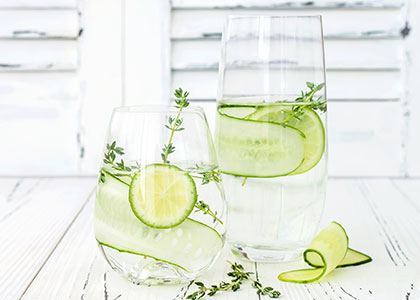
7 Foods to Fight Dry Skin This Winter
By Isabel Smith, MS, RD, CDN
Wintertime is the pits for our skin. Cold weather coupled with dry heat makes it tough for our skin to catch a break. When moisture escapes from the pores on the surface of our skin, dry, sensitive and sometime itchy skin is the result.
Water is the main component of skin that makes it bouncy and full of life — so hydration and water content of food is super important when it comes to keeping skin hydrated in the winter. To help you make choices that can help you to have softer, more moisturized skin here’s a list of a few key foods/fluids to include this winter to keep your skin soft and happy
1. Water
First and foremost: Aim to drink more water. As I mentioned before, heat and cold in the wintertime and the dramatic change from one to the other can cause for dry skin and can promote evaporation of water out of the skin (further promoting dehydration). Water should be the main staple of what you’re consuming. For some, water can be boring to drink — so try to enhance your water by adding fresh fruit, lemon or lime slices or fresh herbs like basil and mint to make the water more exciting. Most of us should aim for about eight 8 oz glasses daily.
2. Cucumber
Cucumbers are a super hydrating fruit (technically because they have seeds) – as cucumbers are mostly made from water. Cucumbers have a high water content and therefore can help to promote you to be more hydrated as a result of eating them (which then can help to hydrate your skin too!). Cucumbers are also a source of silica, a nutrient that can help to promote moisture and elasticity in the skin as well.
How to eat cucumbers: Add them to a juice or smoothie or eat them raw as a snack with your favorite dip like hummus.
3. Wild Salmon
Wild salmon is next up on the hydrating-foods list. Wild salmon is a source of selenium, a nutrient that’s good for the thyroid and also is good for helping the skin to detoxify/rid itself from toxins. The fat in salmon also helps skin to retain moisture.
How to eat wild salmon: Have a piece of roasted, grilled or baked salmon with your next salad or vegetable dish.
4. Sweet Potatoes and Pumpkin
Both sweet potatoes and pumpkin are great for skin due to their rich source of beta carotene (a nutrient that’s also great for helping to prevent skin cancer and protect the skin from the sun’s harmful rays) and also for their water content. Sweet potatoes and pumpkins also contain vitamins A and C, and Vitamin C is a precursor to collagen, which is a key component for healthy and young-looking skin.
How to eat sweet potatoes and pumpkin: Add raw sweet potato to your next juice, and add roasted pumpkin to your next delicious salad! Or have it plain roasted alongside your next holiday dish.
5. Spinach
Spinach is one of my favorite vegetables because it’s so versatile and you can use it in so many different and delicious ways. Spinach is also chock-full of nutrients like vitamins A and C that help to promote healthy skin through production of collagen. Spinach is a rich source of folate that is great for your brain, and it turns out too that the folate and phytonutrients can also help to promote hydrated skin too — not to mention the water content of spinach that’s also helpful in promoting hydrated skin.
How to eat spinach: Add it to your favorite smoothie or salad, or include spinach in your breakfast wok of eggs and other vegetables!
6. Olives and Olive Oil
Olives (and olive oil) are great for healthy and moisturized skin. Olives are loaded with healthy monounsaturated fat that can help to provide anti-inflammatory nutrients that are good for joints, heart health and more. That same anti-inflammatory monounsaturated fat is also great for helping to moisturize the skin as the fat itself can help the skin to retain more moisture.
How to include more olives (and olive oil): Add olives and/or olive oil to your salad, or have a snack of olives for an easy and healthy snack.
7. Dark Chocolate
Dark chocolate is my all time favorite healthy skin food. Dark chocolate is rich in nutrients called flavanols that help to promote hydration through improved circulation and blood flow through the body (which helps to deliver both nutrients and fluid to the skin). Nutrients in chocolate are also rich in antioxidants, which can help to prevent and repair damage done to the skin (and the rest of the body cells). Nutrients in chocolate are also good for preventing age-related cognitive decline. Have I convinced you to have some chocolate yet?
How to eat dark chocolate: Choose raw or unprocessed dark chocolate or cocoa powder to add to your smoothie, your breakfast dish (think cacao nibs) or even as a snack.